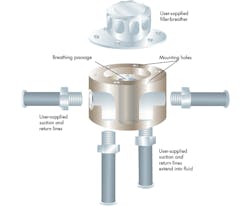No Tee for Two
This file type includes high resolution graphics and schematics when applicable.
Electricians can have it pretty easy when they need to add a simple circuit to an existing one. Assuming the existing circuit can handle the additional electric load, all they have to do is install the new wiring and other components, shut off the power to the main circuit, connect the new circuit to the main one at a junction box, and then restore electrical power.
It isn’t this simple with hydraulics. Instead, after shutting off power, you have to make sure any lines you work on are not pressurized. Only then should you open the hydraulic line you’ll be tapping into, drain the fluid from the line, install a tee or other fitting, and then connect everything back up. However, you have to repeat this process for the return line. But then you’re still not done, because you may have to bleed air from the line, and you certainly should check for leaks.
Now there’s a simpler way. Tom Nell, certified fluid power engineer at Flpwr.com, has developed an adapter that contains connections to draw fluid and return fluid from a hydraulic reservoir. The adapter fits between the reservoir and filler breather. It comes with the hardware to mount the adapter to a standard filler-breather port on a reservoir and provides a mounting surface for mounting a standard filler breather on top of it.
The benefit of the adapter is a pair of SAE -12 ports that each lead to a ¾ in. vertical tube that extends into the hydraulic fluid in the reservoir. One tube can be used for suction and the other for return, simply by connecting suction and return lines to the respective port.
The adapter makes it easy to tap into an existing hydraulic system to add an auxiliary circuit or an off-line filtration circuit (kidney loop). The ports can also be used for adding fresh fluid to the reservoir without having to remove the filler breather cap—which would open the reservoir to atmosphere, especially if the cap is inadvertently left off.
Nell says the adapter can immediately pay for itself several times over just by reducing the labor costs otherwise associated with conventional methods requiring installation of tee fittings.
For more information on the adapter, contact Tom Nell at [email protected].
This file type includes high resolution graphics and schematics when applicable.



